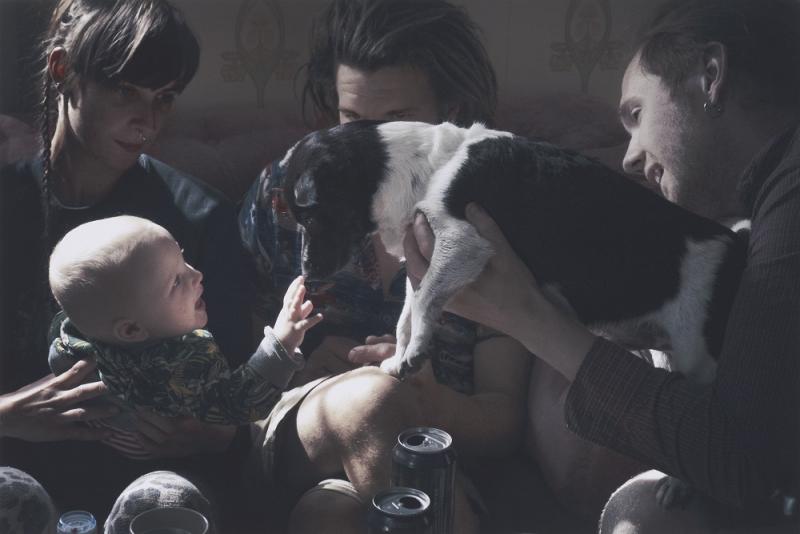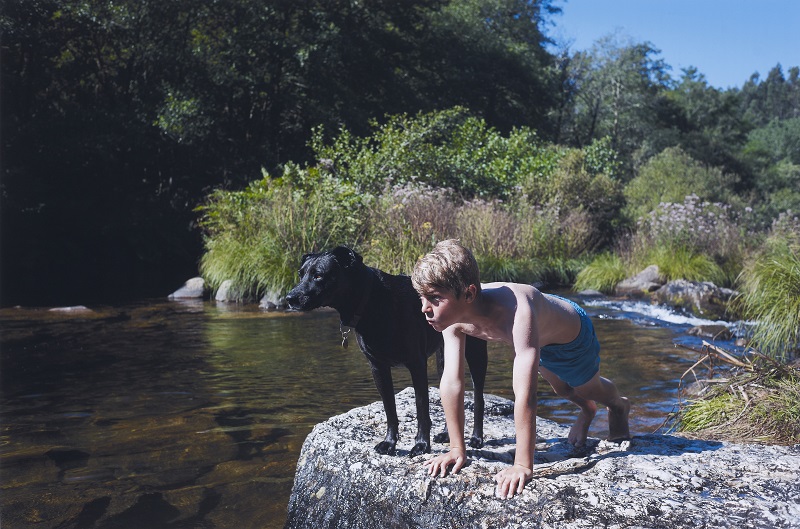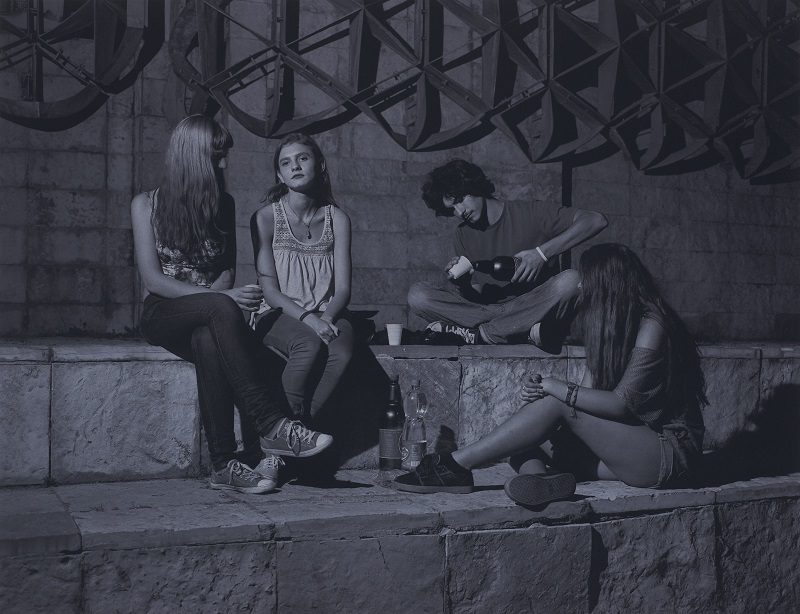Taylor Wessing Photographic Portrait Prize 2014, National Portrait Gallery | reviews, news & interviews
Taylor Wessing Photographic Portrait Prize 2014, National Portrait Gallery
Taylor Wessing Photographic Portrait Prize 2014, National Portrait Gallery
Affectionate family portraits, subtle references to the history of art, and a worthy winner

It is hard to know whether the thematic and stylistic threads running through this year’s Taylor Wessing Prize are evidence of some general shift in approach, or simply reflect the judges’ tastes. In any case, where last year’s shortlist featured stark portraits highlighting the tricky power relationships between photographer and subject, this year’s competition tends towards something gentler and more empathetic – an altogether homelier sort of photography.
Amongst the 59 entries selected for the final exhibition, there is a welcome departure from the camera as an interrogative tool, with a definite whiff of nostalgia in the frequent nods to a more domestic sort of photography that belongs in family albums or framed on mantelpieces. Laurence Cartwright’s Dog and boy, 2013 (Pictured below), shows the photographer’s son crouched next to a dog he befriended while on a family holiday. The boy is mimicking the dog’s posture, still and alert, waiting to jump into the water after a stick or ball. It is beautifully composed, the symmetry of the two forms emphasising the bond between them, while the knowledge that in a minute, or even a second, one of them will move and this perfect scene will be lost forever, lends the scene an elegiac quality. It is an affectionate and humorous family picture, but in its wholesome depiction of a boy playing outside, immersed in nature in an endless summer, it expresses a wistful, universal idealism.
 Sian Davey’s family picnic hints knowingly at art historical antecedents, invoking the rich western tradition of paintings depicting people en plein air; like so many 18th-century images of figures at leisure in a pastoral idyll. The adults, absorbed in their game of backgammon, are oblivious to the bawling, naked child disrupting the centre of the composition, recalling the chubby putti so often present in Arcadia.
Sian Davey’s family picnic hints knowingly at art historical antecedents, invoking the rich western tradition of paintings depicting people en plein air; like so many 18th-century images of figures at leisure in a pastoral idyll. The adults, absorbed in their game of backgammon, are oblivious to the bawling, naked child disrupting the centre of the composition, recalling the chubby putti so often present in Arcadia.
A number of photographs here have a real painterliness about them, with Ben Stockley’s Ángel Nieto, 2013 an arrestingly beautiful portrait of a woman who, eyes downcast, has a face like a Raphael madonna. Photographed at work in what must be a noisy and busy kitchen, the portrait envelops her in stillness, recalling Vermeer’s women absorbed in domestic duties.
David Titlow’s winning portrait is also reminiscent of a Dutch genre painting, both in its depiction of a group completely absorbed, and in the wonderful light that bathes the photographer’s baby son as he is introduced to the family dog (Main picture). The narrative of this central encounter, and the reactions of the adults seated around is made all the more legible and dynamic by the light falling from left to right, guiding our eye across the piece and emphasising the main compositional elements. While this lovely chiaroscuro effect emphasises the image’s painterly quality, and suggests a degree of artfulness in its construction, we are told that this picture is an example of true photographic serendipity, a moment captured in the blink of an eye. In fact, Titlow’s approach is touchingly old-fashioned; in the era of digital photography where images can be endlessly scrutinised and retaken he says, “You never really know what is going to happen – it’s pure magic.”
 David Titlow’s perfect photographic moment might well have earned him a degree of approval from legendary Magnum photographer Henri Cartier-Bresson, who coined the now ubiquitous phrase "the decisive moment" to describe his practice of making a picture "in the camera", at the moment the shutter clicks, with minimal adjustments made in the dark room. Interestingly enough, the most problematic image in the exhibition pays a sort of anti-homage to Cartier-Bresson. Horribly underexposed, and dispensing with mid-tones to highlights, Blerim Racaj’s Indecisive Moment, 2013 is a curiously effective image, although its merits as a portrait are less certain (Pictured above).
David Titlow’s perfect photographic moment might well have earned him a degree of approval from legendary Magnum photographer Henri Cartier-Bresson, who coined the now ubiquitous phrase "the decisive moment" to describe his practice of making a picture "in the camera", at the moment the shutter clicks, with minimal adjustments made in the dark room. Interestingly enough, the most problematic image in the exhibition pays a sort of anti-homage to Cartier-Bresson. Horribly underexposed, and dispensing with mid-tones to highlights, Blerim Racaj’s Indecisive Moment, 2013 is a curiously effective image, although its merits as a portrait are less certain (Pictured above).
Racaj’s group of disenfranchised Kosovan youths drinking in the street was photographed over a long period, with the whole process heavily stage-managed to achieve the desired effect. Racaj simultaneously wanted to realise his own fully formed concept of how the picture would look, while intervening as little as possibly to minimise his subjects' awareness of the camera. Sure enough, there is a troubling disconnect between the photographer and his subjects, and the lack of any upper tonal register has a deadening effect – it is as if a fog has descended, isolating the subjects from the viewer. The effect of orchestrating the image over time also shows, with the action appearing more slowed down than frozen in time – the difference, perhaps, between a film still and a photograph. Does it say much about these individuals? I’m not sure. But as an attempt to portray a generation of young Kosovans facing a bleak and unpromising future, trapped in their own Indecisive Moment, it is both ambitious and disconcerting.
- Taylor Wessing Photographic Portrait Prize 2014 at the National Portrait Gallery until 22 February, 2015
Share this article
Add comment
The future of Arts Journalism
You can stop theartsdesk.com closing!
We urgently need financing to survive. Our fundraising drive has thus far raised £49,000 but we need to reach £100,000 or we will be forced to close. Please contribute here: https://gofund.me/c3f6033d
And if you can forward this information to anyone who might assist, we’d be grateful.

Subscribe to theartsdesk.com
Thank you for continuing to read our work on theartsdesk.com. For unlimited access to every article in its entirety, including our archive of more than 15,000 pieces, we're asking for £5 per month or £40 per year. We feel it's a very good deal, and hope you do too.
To take a subscription now simply click here.
And if you're looking for that extra gift for a friend or family member, why not treat them to a theartsdesk.com gift subscription?
more Visual arts
 'We are bowled over!' Thank you for your messages of love and support
Much-appreciated words of commendation from readers and the cultural community
'We are bowled over!' Thank you for your messages of love and support
Much-appreciated words of commendation from readers and the cultural community
![SEX MONEY RACE RELIGION [2016] by Gilbert and George. Installation shot of Gilbert & George 21ST CENTURY PICTURES Hayward Gallery](https://theartsdesk.com/sites/default/files/styles/thumbnail/public/mastimages/Gilbert%20%26%20George_%2021ST%20CENTURY%20PICTURES.%20SEX%20MONEY%20RACE%20RELIGION%20%5B2016%5D.%20Photo_%20Mark%20Blower.%20Courtesy%20of%20the%20Gilbert%20%26%20George%20and%20the%20Hayward%20Gallery._0.jpg?itok=7tVsLyR-) Gilbert & George, 21st Century Pictures, Hayward Gallery review - brash, bright and not so beautiful
The couple's coloured photomontages shout louder than ever, causing sensory overload
Gilbert & George, 21st Century Pictures, Hayward Gallery review - brash, bright and not so beautiful
The couple's coloured photomontages shout louder than ever, causing sensory overload
 Lee Miller, Tate Britain review - an extraordinary career that remains an enigma
Fashion photographer, artist or war reporter; will the real Lee Miller please step forward?
Lee Miller, Tate Britain review - an extraordinary career that remains an enigma
Fashion photographer, artist or war reporter; will the real Lee Miller please step forward?
 Kerry James Marshall: The Histories, Royal Academy review - a triumphant celebration of blackness
Room after room of glorious paintings
Kerry James Marshall: The Histories, Royal Academy review - a triumphant celebration of blackness
Room after room of glorious paintings
 Folkestone Triennial 2025 - landscape, seascape, art lovers' escape
Locally rooted festival brings home many but not all global concerns
Folkestone Triennial 2025 - landscape, seascape, art lovers' escape
Locally rooted festival brings home many but not all global concerns
 Sir Brian Clarke (1953-2025) - a personal tribute
Remembering an artist with a gift for the transcendent
Sir Brian Clarke (1953-2025) - a personal tribute
Remembering an artist with a gift for the transcendent
 Emily Kam Kngwarray, Tate Modern review - glimpses of another world
Pictures that are an affirmation of belonging
Emily Kam Kngwarray, Tate Modern review - glimpses of another world
Pictures that are an affirmation of belonging
 Kiefer / Van Gogh, Royal Academy review - a pairing of opposites
Small scale intensity meets large scale melodrama
Kiefer / Van Gogh, Royal Academy review - a pairing of opposites
Small scale intensity meets large scale melodrama
 Jenny Saville: The Anatomy of Painting, National Portrait Gallery review - a protégé losing her way
A brilliant painter in search of a worthwhile subject
Jenny Saville: The Anatomy of Painting, National Portrait Gallery review - a protégé losing her way
A brilliant painter in search of a worthwhile subject
 Abstract Erotic, Courtauld Gallery review - sculpture that is sensuous, funny and subversive
Testing the boundaries of good taste, and winning
Abstract Erotic, Courtauld Gallery review - sculpture that is sensuous, funny and subversive
Testing the boundaries of good taste, and winning
 Edward Burra, Tate Britain review - watercolour made mainstream
Social satire with a nasty bite
Edward Burra, Tate Britain review - watercolour made mainstream
Social satire with a nasty bite
 Ithell Colquhoun, Tate Britain review - revelations of a weird and wonderful world
Emanations from the unconscious
Ithell Colquhoun, Tate Britain review - revelations of a weird and wonderful world
Emanations from the unconscious

Comments
It would help if the author
The references to
The references to Cartier-Bresson are specifically related to both Blerim Racaj's Indecisive Moment, and David Titlow's own comment about how his winning picture was made. Cartier-Bresson's methods and ideas about photography are in most ways utterly opposed to digital photography, making him an interesting, if perhaps slightly predictable, figure to invoke in current photographic practice. I confess you've lost me regarding Robert Frank.